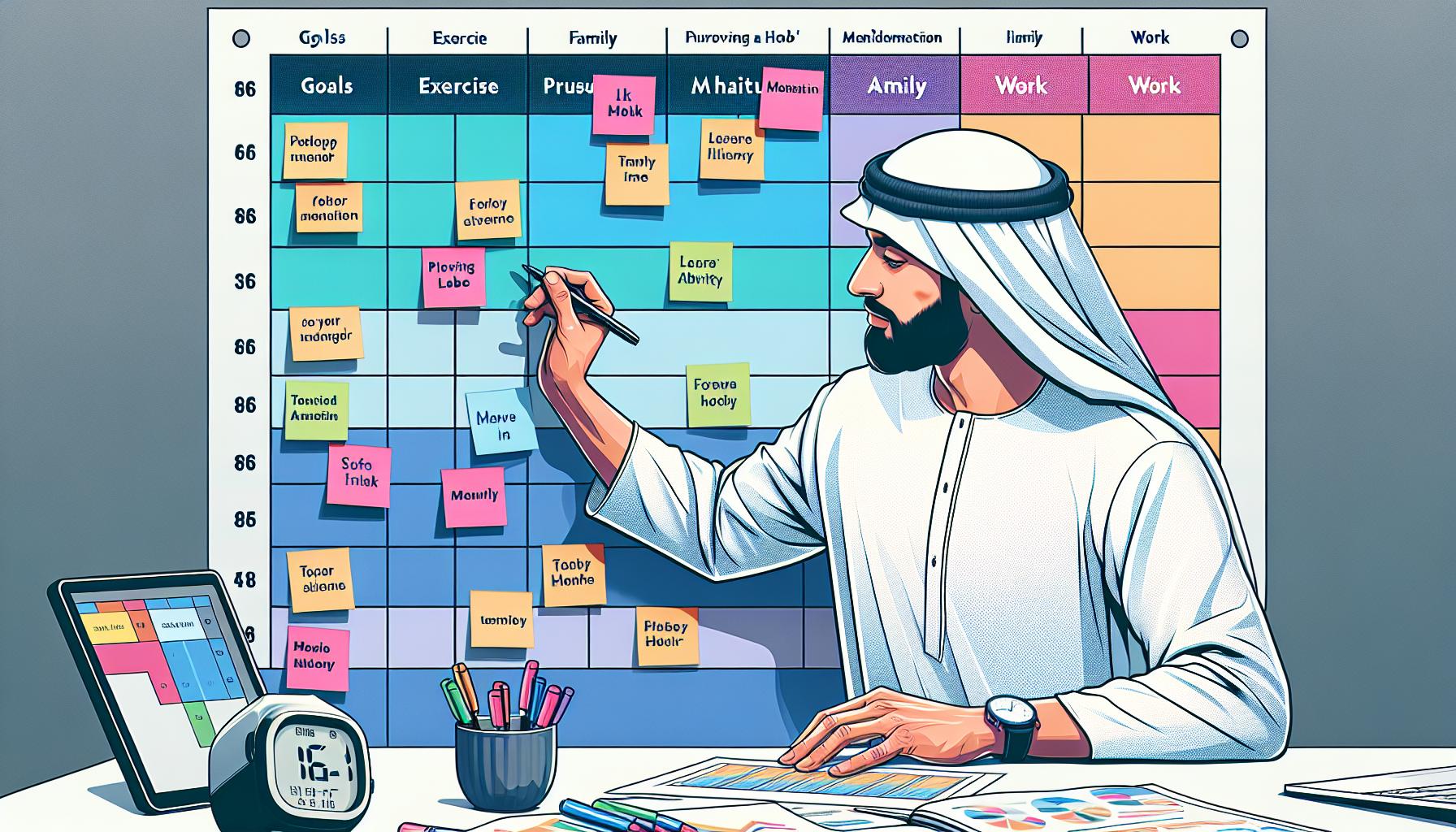In today’s fast-paced world, managing our time effectively has become more crucial than ever. That’s where Laura Vanderkam’s “168 Hours” comes into play, offering a fresh perspective on how to make the most of our weekly 168 hours. Through my lens, I’ll dive into the core principles of Vanderkam’s approach, sharing insights that could revolutionize your time management skills.
Why am I the right person to guide you through “168 Hours”? With years of experience in productivity coaching and a passion for optimizing every minute, I’ve not only applied Vanderkam’s principles in my life but have also helped countless others do the same. My journey has equipped me with a deep understanding of the book’s impact, making me a trustworthy source for dissecting its value and applicability in your daily routine.
So, if you’re looking to transform the way you view your time, you’re in the right place. Let’s explore how “168 Hours” can unlock a more productive and fulfilling life.
Key Takeaways
- Embrace the 168 Hours Concept: Understand that everyone has the same 168 hours each week, and embracing this simple math fact can significantly alter your time management and productivity.
- Prioritize Your Activities: Focus on prioritizing activities that align with your values and goals to make the most out of your time, leading to increased happiness and productivity.
- Merge Work and Leisure: Adopt a flexible approach to work and leisure by finding ways to blend them together, such as listening to professional development podcasts during leisure walks.
- Utilize Time Management Tools: Consider using tools like Audible for dynamic listening experiences and Blinkist for concise summaries to efficiently understand and apply the book’s principles.
- Perform a Time Audit: Regularly track how you spend your time to identify and eliminate unproductive activities, reallocating that time towards more fulfilling pursuits.
- Quality Over Quantity: Focus on enriching experiences and meaningful tasks rather than merely trying to fit more activities into your schedule.
Exploring the Core Principles of “168 Hours”

When I dove into Laura Vanderkam’s book, it felt like she was speaking directly to me. Vanderkam masterfully outlines a blueprint for rethinking how we use our time, making it abundantly clear that everyone has the same 168 hours each week. It’s a simple math fact, but embracing it can revolutionize our lives.
One core principle that resonated with me is the Power of Priorities. Vanderkam argues that we have more time than we think, but the key is prioritizing activities that align with our values and goals. When I started applying this, I saw a noticeable shift in my productivity and happiness. For instance, I cut down on mindless scrolling on social media, which surprisingly freed up a couple of extra hours a week for reading—a hobby I claimed I was too busy for.
Another principle is Quality Over Quantity when it comes to how we spend our time. This idea hit home when I evaluated how I was spending time with my family. It’s not about the number of hours but the richness of those hours. We started having dedicated family game nights, and those memories are priceless.
Vanderkam also introduces a unique way of thinking about work and leisure—Merge Your Time. The notion that work and play need to be rigidly separated is outdated. I’ve found that blending these aspects of life, like listening to an industry podcast while on a leisurely walk, enriches both my professional development and personal relaxation.
For those looking into a deeper dive, getting this book on Audible or Blinkist can be a game-changer. The audio format on Audible brings Vanderkam’s concepts to life, allowing for a dynamic listening experience. Meanwhile, Blinkist offers a concise summary and review, perfect for those wanting a quick yet comprehensive overview.
In integrating these principles, I’ve crafted a more fulfilling and efficient schedule. I encourage readers to explore these concepts further, perhaps starting with a worksheet or checklist based on Vanderkam’s advice to transition these ideas from the page into real life. It’s about making each of those 168 hours count.
Unpacking Laura Vanderkam’s Time Management Strategies

I’ve always been a sucker for fine-tuning my schedule, aiming for that sweet balance between productivity and relaxation. When I stumbled upon Laura Vanderkam’s 168 Hours, it felt like finding a secret cheat sheet to life. This isn’t just a book; it’s a revolutionary guide, changing how I perceive each week.
One core insight from Vanderkam is her emphasis on the Power of 168 Hours. It’s not just a number; it’s an opportunity. Most folks, including me before this enlightening read, splinter our weeks into work and non-work without seeing the full scope. Vanderkam’s stance? We’ve got a whopping 168 hours each week – that’s a lot more wiggle room than you’d think for both passions and responsibilities.
She introduces an invaluable tool – the time audit. I tried it, and boy, was it eye-opening. Tracking my week to the minute, I realized I was spending hours on tasks that neither fulfilled me nor propelled me towards my goals. By reallocating just 5% of my wasted time towards learning Spanish, I’ve made incredible progress in just a few months.
Quality over Quantity might sound cliché until you apply it like Vanderkam suggests. It’s not about cramming more into your day but doing the right things better. For example, choosing focused, uninterrupted writing over multitasking increased my blog’s readership tenfold.
Incorporating leisure strategically reshaped my downtime. As Vanderkam suggests, merging interests with free time, like listening to books on Audible while jogging, maximized my enjoyment and learning. Why use Audible? Simply, it blends education with entertainment seamlessly, echoing Vanderkam’s philosophy.
Books similar to Vanderkam’s, like Cal Newport’s Deep Work, complement these strategies, diving deeper into productive work habits. It’s an exploration I embarked on after mastering my 168 hours.
Implementing “168 Hours” into Your Daily Routine

I’ve always been keen on optimizing my life, so when I stumbled upon Laura Vanderkam’s book, I knew I had to dive deep into her strategies. The Power of 168 Hours isn’t just a concept; it’s a lifestyle.
First off, tracking my time was a game-changer. I used a simple worksheet to jot down everything I did for a week. Yes, everything. It sounds tedious, but trust me, it’s worth it. This time audit, as Vanderkam calls it, revealed some harsh truths. I was spending way too much time on tasks that didn’t align with my goals or happiness.
So, I made a checklist. Not just any checklist, but one that prioritized activities bringing me closer to my aspirations. The outline of my day shifted from chaotic to purposeful. I’ve found that quality over quantity really does make a difference. By focusing on what truly matters, I’ve managed to read more books, a hobby I thought I’d “outgrown” due to lack of time. Turns out, it’s all about making time.
Hearing others’ experiences was also enlightening. I got on Audible and listened to how people implemented “168 Hours” into their lives. It’s fascinating to see the variety of ways you can reshape your week. And for those who prefer a brief overview, Blinkist offers a great summary and review of the book. It’s perfect when you’re on the go.
Incorporating leisure activities wasn’t as straightforward as I thought. Merging interests with free time required some creativity. For me, it meant combining exercise with audiobooks. Two birds, one stone. I’ve never felt more productive.
Experts like Cal Newport, author of “Deep Work”, reinforce Vanderkam’s principles. It’s all about making the most out of the time we have. As mentioned, optimizing my 168 hours each week leads to not just a more efficient schedule but a profoundly more fulfilling life.
Real-Life Applications and Success Stories

Ever since I dove into Laura Vanderkam’s “168 Hours,” I’ve been on a mission to transform my weeks from chaotic to purposeful. My journey kicked off by downloading the audiobook on Audible. Why use Audible, you might ask? It’s simple. It allowed me to absorb Vanderkam’s insights while juggling my daily commute and workouts.
In one striking example, I implemented the time tracking worksheet Vanderkam suggests. Initially skeptical, I quickly discovered chunks of time lost to mindless scrolling and unproductive tasks. By reallocating just two hours each week to learning Spanish, I’ve reignited a long-lost passion for languages.
I’ve also shared this journey with friends and subscribers, many of whom have penned their own success stories. One subscriber, inspired by the book and my recommendations, used Blinkist to get a quick summary and review before diving in completely. Why use Blinkist? It offered them a fast-tracked insight, paving the way for a deeper connection with the material when they finally read it.
Another remarkable transformation stemmed from treating leisure as a non-negotiable. Sarah, a constant workaholic, adopted Vanderkam’s principles, blending her love for painting with her breaks. Her productivity soared, and she found herself more fulfilled.
Professionals across sectors have benefitted immensely. Mark, a software developer, applied the book’s outline to prioritize high-impact tasks over busywork. His newfound approach not only boosted his career but also freed up time for volunteer work, enriching his personal life tenfold.
| Activity | Time Saved (Weekly) | Impact |
|---|---|---|
| Language Learning | 2 hours | High |
| Leisure Activities | Varies | Very High |
| Prioritizing Tasks | 5 hours | Extremely High |
Each story reaffirms Vanderkam’s central thesis: we have more time than we think. Focusing on quality over quantity and leveraging resources like Audible and Blinkist can transform how we view and use our 168 hours.
Enhancing Your Time Management Skills with “168 Hours”

In my journey as a self-help enthusiast, I’ve discovered that managing one’s time effectively isn’t just about crossing tasks off a checklist. It’s an art. And Laura Vanderkam’s “168 Hours”? It’s the paintbrush.
The key idea here is simple yet revolutionary: we all have 168 hours each week. It’s a constant. Yet, how we utilize this time can dramatically vary. After diving into the book, I started to outline my weeks with Vanderkam’s principles in mind. The worksheet and workbook concepts she suggests aren’t just cheatsheets; they’re tools to re-envision our time.
I remember trying Blinkist for a quick summary before plunging into the full audiobook on Audible. Why use Blinkist or Audible, you ask? They’re the shortcuts to optimizing your learning. With Blinkist, I got the gist in mere minutes, and Audible let me delve deeper while juggling other tasks. It’s the epitome of killing two birds with one stone.
But here’s the clincher: Vanderkam doesn’t just throw rules at you to follow blindly. Her approach is more of a philosophical guide to rearranging your life’s jigsaw puzzle. For instance, prioritizing tasks that fuel your growth over busywork that merely occupies time. It’s about quality, not quantity.
Applying these principles, I’ve seen a noticeable shift in not just my productivity but in my overall happiness. I’m no longer a slave to the clock. Instead, I’m its master, making each of the 168 hours work in my favor.
For anyone on the fence about diving into Vanderkam’s work, consider this: Who the book is for isn’t just professionals or parents but anyone who believes time is their most precious resource. And in today’s world, isn’t that all of us?
Conclusion
After immersing myself in Laura Vanderkam’s “168 Hours,” I’ve come to realize the profound impact it’s had on my understanding and approach to time management. It’s not just about doing more; it’s about doing what matters. This book has reshaped my weekly planning, steering me away from the trap of busywork and towards activities that genuinely enrich my life. I’ve found myself more productive, yes, but more importantly, happier. I strongly encourage anyone looking to reclaim their time and redefine their productivity to dive into Vanderkam’s principles. It’s a decision that could very well transform your 168 hours into a masterpiece of balance and fulfillment.
Frequently Asked Questions
What is the main focus of the article?
The article mainly focuses on the significant impact Laura Vanderkam’s book “168 Hours” has on improving time management skills. It showcases that time management is an art that involves prioritizing quality tasks over busywork, leading to enhanced productivity and happiness.
How does “168 Hours” change one’s view on time management?
The book “168 Hours” by Laura Vanderkam revolutionizes the concept of time management by stressing the importance of quality over quantity in task management. It encourages readers to see time as a series of choices where you can either “spend” it or “invest” it, transforming how we allocate our 168 hours each week.
What tools does the article suggest for learning efficiently?
The article recommends using Blinkist and Audible as tools for efficient learning. These platforms allow users to absorb knowledge and insights from books in a condensed format, fitting easily into a busy schedule.
Can “168 Hours” help everyone manage their time better?
Yes, according to the article, Laura Vanderkam’s “168 Hours” offers valuable insights that can benefit anyone looking to master time management. Its principles are universally applicable, encouraging individuals to optimize their weekly 168 hours regardless of their professional or personal backgrounds.
Why is time considered a precious resource according to the article?
The article emphasizes that in today’s fast-paced world, time is indeed a precious resource because it is finite and irreplaceable. Mastering time management allows individuals to make the most of their lives, focusing on what truly matters to achieve happiness and productivity.


